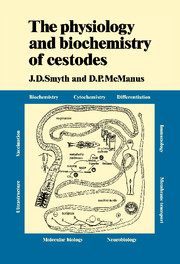Book contents
- Frontmatter
- Contents
- Preface
- Acknowledgements
- 1 The cestodes: general considerations
- 2 The adult cestode: special structural features relevant to its physiology
- 3 The adult cestode in its environment
- 4 The adult: general metabolism and chemical composition; lipid metabolism
- 5 The adult: carbohydrate metabolism
- 6 The adult: proteins and nucleic acids
- 7 The biology of the egg
- 8 Developmental biology of larvae
- 9 Development within definitive host
- 10 Cultivation of cestodes in vitro
- 11 Immunobiology of cestodes
- References
- Index
2 - The adult cestode: special structural features relevant to its physiology
Published online by Cambridge University Press: 24 November 2009
- Frontmatter
- Contents
- Preface
- Acknowledgements
- 1 The cestodes: general considerations
- 2 The adult cestode: special structural features relevant to its physiology
- 3 The adult cestode in its environment
- 4 The adult: general metabolism and chemical composition; lipid metabolism
- 5 The adult: carbohydrate metabolism
- 6 The adult: proteins and nucleic acids
- 7 The biology of the egg
- 8 Developmental biology of larvae
- 9 Development within definitive host
- 10 Cultivation of cestodes in vitro
- 11 Immunobiology of cestodes
- References
- Index
Summary
General considerations
The general morphology of cestodes, including the ultrastructure, is now too well known to be reviewed at length here. It should be noted, however, that the traditional concept of the tapeworm strobila being divided into discrete ‘segments’ or ‘proglottides’ is largely illusionary, in that although the strobila is constricted at intervals between segments, the interior is filled with uninterrupted parenchymal cells and longitudinal muscles throughout the whole length of the body (519). Valuable reviews of the basic structure and/or ultrastructure are those of Arme & Pappas (27,28) and Threadgold (878) on cestodes in general and that of Arai (19) on Hymenolepis spp. in particular. In this chapter therefore, with the exception of the tegument, which is discussed in some detail, only those morphological features of particular physiological interest are considered.
The tegument
General considerations
Because tapeworms lack a gut, all nutritive material must pass through the body surface and waste materials likewise be eliminated through it. it. The basic structure may, in fact, be compared with a gut turned inside out, with the body covering or tegument (Fig. 2.1) serving the absorptive functions normally associated with the intestinal mucosa (Fig. 2.2). The structure and physiology of the tegument is, therefore, of fundamental importance to the understanding of cestode physiology as a whole and has received considerable attention.
- Type
- Chapter
- Information
- The Physiology and Biochemistry of Cestodes , pp. 5 - 34Publisher: Cambridge University PressPrint publication year: 1989
- 3
- Cited by



